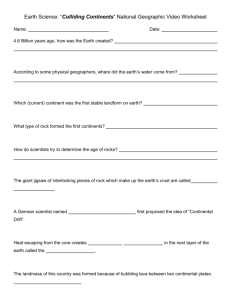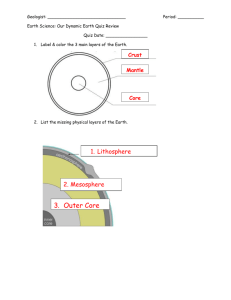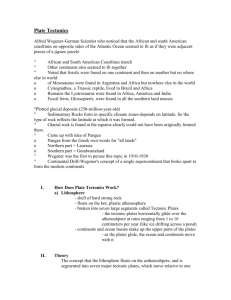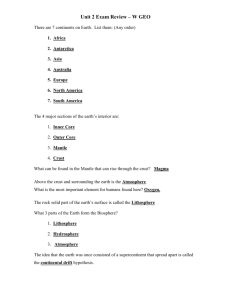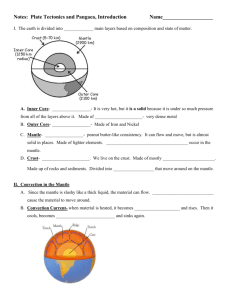Q1. (a) The diagram shows the Earth's layered structure. Name parts
advertisement
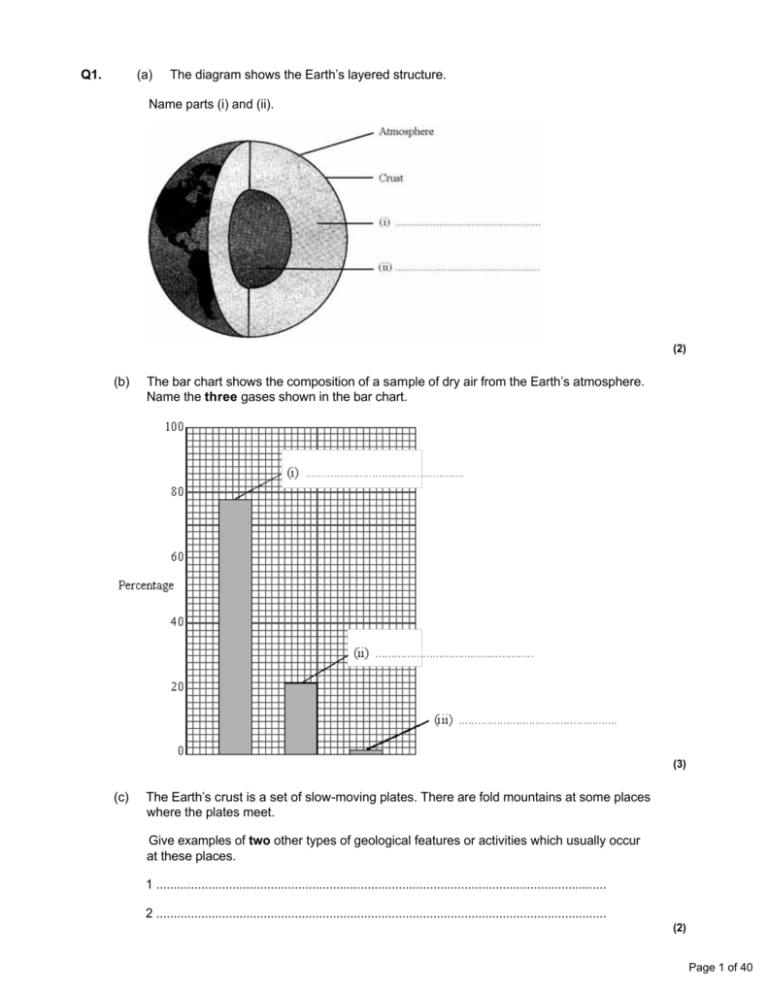
Q1. (a) The diagram shows the Earth’s layered structure. Name parts (i) and (ii). (2) (b) The bar chart shows the composition of a sample of dry air from the Earth’s atmosphere. Name the three gases shown in the bar chart. (3) (c) The Earth’s crust is a set of slow-moving plates. There are fold mountains at some places where the plates meet. Give examples of two other types of geological features or activities which usually occur at these places. 1 .................................................................................................................................. 2 .................................................................................................................................. (2) Page 1 of 40 (d) One carbon compound is methane. Its chemical formula is CH4. (i) What is the name of the element which is combined with carbon in methane? ........................................................................................................................... (1) (ii) Complete the word equation for the chemical reaction which usually takes place when methane burns. methane +.................................. → carbon dioxide + water (1) (Total 9 marks) Q2. (a) Scientists think that South America and Africa were once joined together. The diagram gives evidence for this idea. Which two of the following statements give evidence that Africa and South America were once joined together? Tick ( ) the box next to each of your choices. There are active volcanoes in Africa and South America. Fossils of cynognathus are found in Africa and South America. The shapes of the west coast of Africa and the east coast of South America almost fit together. There are deserts in Africa and South America. Earthquakes occur in Africa and South America. (2) Page 2 of 40 (b) Complete these sentences by choosing the correct words from the box. Each word may be used once or not at all. continental mantle crust earthquake mountain evolution tectonic The theory of ........................................... drift can explain how Africa and South America moved apart and why both have mountain ranges. Many scientists did not agree with the theory. They thought that mountains were formed because the Earth had cooled down, making the ................................... shrink. Many years later other scientists found that the Earth’s lithosphere was broken into a number of large pieces. These pieces, called ........................................... plates, are moving apart very slowly. (3) (Total 5 marks) Q3. (a) During the first billion years of the Earth’s existence, there were many active volcanoes. The volcanoes released the gases that formed the early atmosphere. Describe how volcanoes caused the oceans to be formed. ..................................................................................................................................... ..................................................................................................................................... ..................................................................................................................................... ..................................................................................................................................... (2) Page 3 of 40 (b) The atmosphere on Earth today is very different from the early atmosphere. The pie chart shows the amounts of different gases in the air today. Choose gases from the box to label the pie chart. argon carbon dioxide hydrogen nitrogen oxygen (2) (Total 4 marks) Q4. (a) (i) The diagram gives information about some of the layers that make up the Earth. What name is given to the outer layer of the Earth labelled X? ........................................................................................................................... ........................................................................................................................... (1) (ii) What is the difference between the inner core and the outer core? ........................................................................................................................... ........................................................................................................................... (2) Page 4 of 40 (b) Which of the following is used to detect the waves produced by an earthquake? Draw a ring around your answer. barograph seismograph tachograph (1) (Total 4 marks) Q5. A headline from 27 December 2004 read: (a) Use words from the box to complete the sentences about earthquakes. convection radioactive tectonic volcanic The earthquake was caused by the movement of two of the Earth’s ......................................................... plates. The energy for this movement comes from the heat released by natural ......................................................... processes. (2) (b) It was estimated that 300 000 people died as a result of the tsunami in 2004. Some newspapers criticised scientists for not predicting the tsunami, because if people had been warned they could have moved to safety. Page 5 of 40 (i) Suggest why we can only estimate that 300 000 people died as a result of the tsunami. ......................................................................................................................... ......................................................................................................................... ......................................................................................................................... ......................................................................................................................... (2) (ii) Explain why scientists could not have predicted the tsunami. ......................................................................................................................... ......................................................................................................................... ......................................................................................................................... ......................................................................................................................... (2) (Total 6 marks) Q6. Earthquakes are common in certain places on Earth. (a) The diagram shows the layered structure of the Earth. Choose one word from the box to complete the label on the diagram. atmosphere core plate (1) Page 6 of 40 (b) In 1935 C.F. Richter designed a scale for comparing the size of earthquakes. A newspaper reported that an earthquake off the coast of Kent had caused plaster to come down from ceilings, house tiles to loosen and church bells to ring. (i) Earthquakes happen often in the UK. Suggest why most of these earthquakes are not reported in the newspapers. ........................................................................................................................... ........................................................................................................................... (1) (ii) Draw a ring around the number which best shows the size of the earthquake in Kent. 1 4 6 8 (1) (iii) State what causes earthquakes. ........................................................................................................................... ........................................................................................................................... (1) Page 7 of 40 (iv) Why were people living in Kent not warned about this earthquake? ........................................................................................................................... ........................................................................................................................... (1) (Total 5 marks) Q7. Evidence shows that the Earth formed from a molten ball of rocks and minerals. Before 1900 many scientists thought that the Earth’s mountains and continents formed in fixed positions when the molten ball of rocks and minerals cooled and wrinkled. (a) In 1912 Alfred Wegener suggested his hypothesis of continental drift. The areas of rocks shown on Map 1 contain fossils of the same type of animals. Today animals in Africa are different from animals in South America. Map 1 Wegener suggested his hypthesis that all of the continents, including Africa and South America, had been joined together but then drifted slowly apart. (i) Map 2 In 1920 other scientists stated that all of the continents were in fixed positions, including Africa and South America, and that they had once been joined together by a land bridge. Use the information to suggest two pieces of evidence that may have led Wegener to propose his hypothesis that continents move. ............................................................................................................... ............................................................................................................... ............................................................................................................... ............................................................................................................... (2) Page 8 of 40 (ii) Suggest why, in 1920, other scientists thought that Wegener’s hypothesis was wrong. ............................................................................................................... ............................................................................................................... ............................................................................................................... ............................................................................................................... (2) (b) In 1962 scientists produced the theory of plate tectonics. The theory of plate tectonics supported Wegener’s hypothesis that continents move. Tectonic plates move a few centimetres a year. Complete the sentences about what causes the movement of the Earth’s tectonic plates. Deep inside the Earth ........................................ processes release large amounts of energy. These processes heat up the substances in the Earth’s ........................................ producing convection currents. (2) (Total 6 marks) Page 9 of 40 Q8. There are many ideas about the formation of the Earth and its atmosphere from a molten ball of rock and minerals. (a) One idea is that the Earth’s early atmosphere and average surface temperature were probably like that of Venus today. The table shows information about the Earth and Venus today. Percentage composition of atmosphere Name of gas Earth today Venus today Nitrogen 78 3.5 Oxygen 21 a trace Argon 0.97 a trace Carbon dioxide 0.03 96.5 Average surface temperature 20 °C 460 °C There is a variable amount of water vapour in both atmospheres. (i) How was the Earth’s early atmosphere formed? ........................................................................................................................... ........................................................................................................................... (1) (ii) The Earth’s average surface temperature decreased over time. At what temperature would oceans have started to form? Temperature = ......................... °C (1) (iii) Describe how the evolution of plants changed the Earth’s atmosphere. ........................................................................................................................... ........................................................................................................................... ........................................................................................................................... ........................................................................................................................... (2) Page 10 of 40 (b) Another idea was that the Earth’s mountains and continents formed in fixed positions as the molten ball of rock and minerals cooled and wrinkled. Wegener, in 1915, had the idea that the Earth’s crust and the upper part of the mantle had cracked into plates that were able to move. His idea meant that the mountains and continents were not in fixed positions. (i) Give one piece of evidence that led to Wegener’s idea being accepted. ........................................................................................................................... ........................................................................................................................... (1) (ii) Describe what causes the Earth’s tectonic plates to move. ........................................................................................................................... ........................................................................................................................... ........................................................................................................................... ........................................................................................................................... ........................................................................................................................... ........................................................................................................................... (3) (Total 8 marks) Page 11 of 40 Q9. A map of the world shows that the outline of South America looks as if it would fit into the west coast of Africa. • Alfred Wegener in 1920 suggested his idea that the continents had been joined together but then slowly drifted apart. • Other scientists in 1920 said that the continents were fixed on solid Earth and had been joined by a land bridge. Modern South American animals are different from modern African animals. Most fossils of animals found in South America and Africa are exactly the same. (a) Consider the information above. (i) What evidence gave Wegener the idea that the continents of South America and Africa had been joined? .......................................................................................................................... .......................................................................................................................... (1) (ii) Suggest two reasons why the other scientists in 1920 thought that Wegener was wrong. 1 ....................................................................................................................... .......................................................................................................................... 2 ....................................................................................................................... .......................................................................................................................... (2) Page 12 of 40 (b) Complete the sentences by writing in the correct words. Recent evidence has supported Wegener’s idea. The Earth’s .................................. and the upper part of the mantle are now thought to be composed of tectonic plates. Heat released by radioactive processes causes convection currents within the Earth’s .................................. These convection currents cause the plates to move a few centimetres per ................................... (3) (Total 6 marks) Q10. (a) Two hundred years ago, scientists thought that the Earth was about 400 million years old. This estimate came from the idea that the centre of the Earth was still molten. More recently, measurement of radioactivity in rocks has shown that the Earth is much older than 400 million years. Suggest one reason why scientists now know that the Earth is much older than 400 million years. ..................................................................................................................................... ..................................................................................................................................... (1) Page 13 of 40 (b) About one hundred years ago there was a scientist called Alfred Wegener. He found evidence that the continents, such as South America and Africa, had once been joined and then drifted apart. Use the diagram to suggest two pieces of evidence that could be used to show that the continents had once been joined. 1 .................................................................................................................................. ..................................................................................................................................... 2 .................................................................................................................................. ..................................................................................................................................... (2) (c) About fifty years ago, new evidence convinced scientists that the Earth’s crust is made up of tectonic plates that are moving very slowly. Give two pieces of evidence that have helped to convince these scientists that the tectonic plates are moving. 1 .................................................................................................................................. ..................................................................................................................................... 2 .................................................................................................................................. ..................................................................................................................................... (2) (Total 5 marks) Page 14 of 40 Q11. The Earth is shaped like a sphere and is surrounded by an atmosphere. (a) The diagram shows a section of the layered structure of the Earth. (i) Complete the diagram by writing in the missing label. (1) (ii) Earthquakes within the Earth’s crust can be sudden and disastrous. Scientists cannot accurately predict when earthquakes will occur. Explain why. To obtain full marks you must support your answer with a description of what causes earthquakes. .......................................................................................................................... .......................................................................................................................... .......................................................................................................................... .......................................................................................................................... .......................................................................................................................... .......................................................................................................................... .......................................................................................................................... .......................................................................................................................... (4) Page 15 of 40 (b) Some theories suggest that the Earth’s early atmosphere was like the atmosphere of Mars today. The atmosphere of Mars today The atmosphere of Earth today Carbon dioxide % 95 0.03 Nitrogen % 3 Gases (i) Argon % 1.5 0.97 Oxygen % 0.5 21 Complete the table by writing in the percentage of nitrogen in the atmosphere of Earth today. (1) (ii) Use the information in the table to describe the changes that have happened to two of the gases in the Earth’s atmosphere. Explain what has caused these changes. .......................................................................................................................... .......................................................................................................................... .......................................................................................................................... .......................................................................................................................... .......................................................................................................................... .......................................................................................................................... .......................................................................................................................... .......................................................................................................................... (4) (Total 10 marks) Page 16 of 40 Q12. (a) The diagram shows the layered structure of the Earth. (i) Write in the boxes the name of layer X and the name of layer Y. (2) (ii) The overall density of the Earth is about 5500 kg/m3. The average density of the rocks in the Earth’s crust is about 2800 kg/m3. What does this suggest about the material that makes up the lower layers of the Earth? .......................................................................................................................... .......................................................................................................................... .......................................................................................................................... .......................................................................................................................... (2) (b) In 1915, the scientist Alfred Wegener suggested that Africa and South America had once been joined but had since drifted apart. Evidence for his theory came from the animal fossils found in the two continents. The fossils are almost the same, although animals now living in Africa and South America are different. Other scientists did not agree with Wegener and suggested that a land bridge had once joined the two continents. Page 17 of 40 How could scientists use the idea of a land bridge to explain the evidence put forward by Wegener? ..................................................................................................................................... ..................................................................................................................................... ..................................................................................................................................... ..................................................................................................................................... (2) (c) Scientists now think that the outer layer of the Earth is cracked into a number of large pieces called tectonic plates. The tectonic plates are moving very slowly. The lines on the diagram show the boundaries between the major tectonic plates. (i) Explain why there are no major earthquakes in Britain. .......................................................................................................................... .......................................................................................................................... .......................................................................................................................... .......................................................................................................................... (2) (ii) What is causing the tectonic plates to move? .......................................................................................................................... .......................................................................................................................... (1) (Total 9 marks) Page 18 of 40 Q13. The diagram represents a section through the Earth showing the layers which are labelled A, B, C and D. (a) Give the name of: (i) layer A ............................................................................................................. (ii) layer B ............................................................................................................. (2) (b) Give one difference between layer C and layer D. .................................................................................................................................... .................................................................................................................................... (1) (Total 3 marks) Q14. The following information suggests that South America and Africa were once attached and then moved apart. Page 19 of 40 Suggest when South America and Africa began to move apart. [Make use of dates in your answer, where possible.] ............................................................................................................................................... ............................................................................................................................................... ............................................................................................................................................... ............................................................................................................................................... ............................................................................................................................................... (Total 3 marks) Q15. In 1935 C.F. Richter designed a scale for comparing the size of earthquakes. A newspaper reported that an earthquake off the coast of Kent had caused plaster to come down from ceilings, house tiles to loosen and church bells to ring. Page 20 of 40 The epicentre is the place on the surface of the Earth directly above where the earthquake occurs. (a) Suggest why the earthquake in Kent was reported and why most earthquakes in the UK are not reported. ..................................................................................................................................... ..................................................................................................................................... ..................................................................................................................................... ..................................................................................................................................... (2) (b) Explain how earthquakes are caused. ..................................................................................................................................... ..................................................................................................................................... ..................................................................................................................................... ..................................................................................................................................... ..................................................................................................................................... ..................................................................................................................................... (3) (c) People living in Kent were not warned about this earthquake. In terms of what is happening within the Earth, explain the problems of trying to predict earthquakes. ..................................................................................................................................... ..................................................................................................................................... ..................................................................................................................................... ..................................................................................................................................... (2) (Total 7 marks) Page 21 of 40 Q16. The Peru-Chile trench runs down the west coast of South America. It is the boundary between two tectonic plates that are slowly moving towards each other. Source: Witney, Drozdowska and Maile, AQA GCSE Physics (Hodder & Stoughton) 2002. Adapted and reproduced by permission of Hodder & Stoughton. Explain what causes the tectonic plates to move. ............................................................................................................................................... ............................................................................................................................................... ............................................................................................................................................... ............................................................................................................................................... (Total 2 marks) Q17. The diagram below shows a cross-section of a mid-ocean ridge. Page 22 of 40 (a) X and Y are two separate tectonic plates. (i) The two plates are both moving. Explain, as fully as you can, what causes tectonic plates to move. .......................................................................................................................... .......................................................................................................................... .......................................................................................................................... .......................................................................................................................... .......................................................................................................................... .......................................................................................................................... (3) (ii) New ocean floor is created at the mid-ocean ridge. Explain, as fully as you can, how this happens. .......................................................................................................................... .......................................................................................................................... .......................................................................................................................... .......................................................................................................................... .......................................................................................................................... .......................................................................................................................... (3) (b) The layer of sediment that has collected on the ocean floor increases in depth the further it is from the mid-oceanic ridge. Suggest a reason for this. .................................................................................................................................... .................................................................................................................................... .................................................................................................................................... .................................................................................................................................... (2) (Total 8 marks) Page 23 of 40 Q18. The diagram shows a view of the inside of the Earth. Adapted from Physics for You (1996) by Keith Johnson, Nelson Thornes (a) The curved lines marked X show two of the slow currents in the mantle. (i) What sort of currents are these? .......................................................................................................................... (1) (ii) How do these currents occur and what is their energy source? .......................................................................................................................... .......................................................................................................................... .......................................................................................................................... .......................................................................................................................... .......................................................................................................................... .......................................................................................................................... (3) (b) Movements of the plates of the Earth’s crust can result in earthquakes. Give two other geological results of these movements. 1 .................................................................................................................................. 2 .................................................................................................................................. (2) (Total 6 marks) Page 24 of 40 Q19. (a) Apart from water vapour, two gases account for about 99% of the present atmosphere of our planet. What are the names of these gases? .......................................................... and ........................................................ (1) (b) Scientists now have evidence that, over three billion years ago, our planet’s atmosphere was mostly a mixture of water vapour, carbon dioxide, methane and ammonia. Since then the mixture has gradually changed. (i) Suggest why there is now less water vapour in the atmosphere. .......................................................................................................................... .......................................................................................................................... .......................................................................................................................... .......................................................................................................................... (2) (ii) Suggest why there is now less carbon dioxide in the atmosphere. .......................................................................................................................... .......................................................................................................................... .......................................................................................................................... .......................................................................................................................... (2) (c) The following information suggests that the continents of Africa and South America were once joined together but then began to move apart. Fossilised remains of a large fern-like plant called Glossopteris have been found in the rocks of the Carboniferous period in both Africa and South America. Fossilised remains of a freshwater reptile called Mesosaurus have been found in the rocks of the Permian period in both Africa and South America. Page 25 of 40 No fossils of identical organisms have been found in the rocks of the Jurassic or the Cretaceous period in Africa or South America. The following table gives the names of some of the periods in our planet’s geological history. (i) Start of the period millions of years ago Name of the period 2 Quaternary 65 Tertiary 136 Cretaceous 190 Jurassic 225 Triassic 280 Permian 345 Carboniferous 395 Devonian 435 Silurian 500 Ordovician 570 Cambrian Use this information to suggest when Africa and South America began to move apart. About ......................................................... million years ago. (1) (ii) What conditions were necessary for Africa and South America to move apart? .......................................................................................................................... .......................................................................................................................... .......................................................................................................................... .......................................................................................................................... .......................................................................................................................... .......................................................................................................................... (3) (Total 9 marks) Page 26 of 40 M1. (a) (i) mantle 1 (ii) core or outer core do not credit inner core 1 (b) (i) nitrogen accept N2 only 1 (ii) oxygen accept O2 only 1 (iii) argon accept Ar accept inert gas(es) or noble gas(es) not just 'other gases' 1 (c) any two from * earthquake(s) or tremor(s) or seismic waves or tsunami not tidal waves * volcano(es) or volcanic activity / sill(s) dyke(s) / lava flow(s) * (oceanic) trench(es)/ destructive margins accept named feature e.g. Pacific Trench accept vents * rift(s) accept named feature e.g. Great Rift Valley not valleys * subduction / collision zones accept fault(s) * (oceanic) ridges / constructive margins recycling of rocks accept named feature * forms new islands e.g. Mid-Atlantic Ridge 2 Page 27 of 40 (d) (i) hydrogen do not credit H 1 (ii) oxygen do not credit air accept O2 1 [9] M2. (a) fossils of Cynognathus are found in Africa and South America 1 the shapes ………. almost fit together only two boxes should be ticked deduct 1 mark for each additional box to a minimum mark of 0 1 (b) continental 1 crust 1 tectonic 1 [5] M3. (a) (i) water vapour given out from volcano accept steam not hydrogen and oxygen combining to form water 1 condensed accept rain / clouds formed just ‘cools’ is insufficient 1 (b) nitrogen (left) N do not accept N 1 oxygen (right) O do not accept O 1 [4] Page 28 of 40 M4. (a) (i) crust 1 (ii) inner core is solid do not accept just rock 1 outer core is liquid inner core is denser / hotter than outer core gets 2 marks accept one is solid and one is liquid for 1 mark accept they are different densities for 1 mark wrong way round = 0 marks 1 (b) seismograph 1 [4] M5. (a) tectonic words must be in correct places 1 radioactive 1 (b) (i) any two from: • records not available / made / accurate • bodies not found • affected many islands / large area 2 (ii) any two from: • cannot predict earthquakes / plate movement • (cannot) accurately (predict earthquakes) • (earthquakes / tsunamis) are random / not regular / sudden • do not know what is happening below / in the Earth’s crust / in the mantle • very slow / thousands of years build up of pressure ignore references to technology / equipment 2 [6] M6. (a) core 1 Page 29 of 40 (b) (i) 3 or below / low on the Richter scale accept vibrations not felt / causes no damage ignore references to injuries 1 (ii) 4 1 (iii) movement of (Earth.s / tectonic) plates allow plates collide 1 (iv) (earthquakes) cannot be predicted / sudden / without warning / random ignore under / in the sea 1 [5] M7. (a) (i) the continents of South America and Africa would have fitted together like a jigsaw 1 there are matching / similar rocks / fossils on the continents of South America and Africa 1 (ii) other scientists thought that continents are fixed / cannot float or Wegener had no evidence to prove that continents can move allow Wegener was not respected by other scientists / PhD in astronomy 1 and that a land bridge could explain the matching / similar rocks / fossils on the continents of South America and Africa 1 (b) radioactive 1 mantle 1 words must be in the order shown [6] M8. (a) (i) (gases from) volcanoes 1 (ii) 100 allow 99 1 Page 30 of 40 (iii) any two from: • photosynthesis • carbon dioxide used allow carbon dioxide decreased • oxygen produced allow oxygen increased ignore nitrogen / respiration they = plants 2 (b) (i) any one from: • sea floor spreading accept oceanic ridges / magnetic stripes • periodic measurements between continents accept continents move a few centimetres each year • evidence from rocks / fossils on different continents accept continents fit together • new mountain ranges accept new islands 1 (ii) in the mantle any two from: • convection (currents) / movement do not accept movement of the plates • radioactivity / radioactive decay / nuclear reactions 1 • releases heat / thermal energy accept heat from core 2 [8] M9. (a) (i) old animals / fossils / rocks match (when the continents are put together) or (continents) fit together ignore ‘they are the same shape’ 1 Page 31 of 40 (ii) any two from: • continents / plates cannot move (thousands of kilometres) accept the continents / plates are attached to the Earth or continents / plates cannot drift / float • modern / new animals are different • a land bridge (could explain the matching fossils / rocks) ignore ‘no evidence’ ‘no proof’ ‘no reputation’ 2 (b) crust allow lithosphere 1 mantle 1 year 1 [6] M10. (a) radioactivity (keeps the core hot) accept half-life of radioactive elements has proved the Earth is older than 400 million years accept the Earth is not cooling do not accept fossil / rock evidence 1 (b) any two from: • the shapes of the two continents fit together (like a jigsaw) OWTTE\ do not accept the continents / they are the same shape • the same type of rocks have been found accept ‘rocks match’ • the same fossils have been found accept ‘fossils match’ • rising magma rising through a gap under the Atlantic 2 Page 32 of 40 (c) any two from: • earthquakes accept seismic waves • volcanoes • idea of distance between America and Europe / Africa is increasing e.g. continental drift • oceanic ridges accept ocean floor spreading • formation of (new) mountain ranges accept fold mountains or mountains increasing in height_ • formation of (new) islands • magnetic stripes • tsunamis 2 [5] Page 33 of 40 M11. (a) (i) core 1 (ii) plate (boundaries) accept parts of the crust ignore crust alone 1 sudden movement / colliding accept movement but ignore movement apart or normally move a few centimetres per year accept continental drift 1 convection currents / driven by heat from radioactive processes / decay idea of source of energy for the movement 1 the idea of uncertainty with an explanation eg scientists do not know (with any certainty) • what happens under the crust • where the forces / pressure are building up • we cannot measure the forces • when the forces reach their limit ignore references to volcanoes 1 (b) (i) 78 (ii) marks awarded for any 2 gases from the following 3 gases max 3 marks from CO2 1 any four from: ignore references to respiration carbon dioxide has decreased: • used by plants / bacteria (stromatolites) • during photosynthesis (must be linked to CO2 decrease) • ‘locked up’ in (sedimentary) rocks / carbonates / fossil fuels • dissolved in oceans Page 34 of 40 and / or oxygen has increased because: • released by plants / bacteria (stromatolites) • during photosynthesis (must be linked to O2 increase) and / or nitrogen has increased because • ammonia reacted with oxygen (to release nitrogen) • nitrogen is released by bacteria 4 [10] M12. (a) (i) X – mantle 1 Y – inner core do not accept solid core 1 (ii) different to the crust or contains a lot of (heavy) metals accept iron and nickel for metals 1 higher (average) density or denser density higher than 5500 (kg/m3) gets 2 marks 1 (b) animals were able to move from one continent to the other 1 (when bridge broke) animals evolved differently accept animals adapted differently 1 (c) (i) earthquakes occur at the boundary between plates or earthquakes occur where plates push against each other 1 there are no plate boundaries running through Britain 1 (ii) convection currents (in the mantle) or heat released by (natural) radioactive processes accept Britain is not near the edge of a plate 1 [9] Page 35 of 40 M13. (a) Layer A = crust / tectonic plates / (not named type of rock) Layer B = mantle / magma each for 1 mark 2 (b) Layer C is liquid / molten (accept mostly liquid) but layer D is solid Layer D is more dense than layer C. / accept they have different densities Layer D is hotter than layer C. / accept they have different temperatures (Do not accept hardness / viscosity) any one for 1 mark 1 [3] M14. idea that: continents had not drifted apart at the end of the Permian period continents had not drifted apart 230 million years ago* continents moved apart before the Jurassic period continents moved apart prior to 195 million years ago* continents moved apart in Triassic period (* credit single figure in range 195-230 million years ago) any 3 for 1 mark each with 1 mark [3] M15. (a) (Kent reported because) damage was caused or it was above 3 (on the Richter scale) accept description of damage 1 (others not reported because) no vibrations / not felt / not noticed allow below 3 (on Richter scale) ignore no damage 1 (b) movement of (tectonic) plates allow collision of plates or plates rubbing together or plates pushing against each other 1 any two from: • vibration / (shock)waves (in the earth) or p and s waves accept sudden jolts / slips • caused by convection currents (in the mantle) • heat / energy released from radioactive processes 2 Page 36 of 40 (c) any two from: scientists do not know: • what happens under the crust / mantle / under the surface accept anything under the crust • where forces / pressures are building up • how to measure these forces / pressures • when these forces / pressures reach their limit accept there is no pattern ignore random / speed of movement 2 [7] M16. • heat released from (natural) radioactive decay 1 • causes convection (currents) in the mantle / underneath the crust do not accept in the magma 1 [2] M17. (a) (i) convection currents in the mantle (1) driven by heat (1) from radioactive processes (1) 3 (ii) plates moving apart magma rises to fill gap forms new rock each for 1 mark 3 (b) Rock further from ridge is older more time for sediment to settle each for 1 mark 2 [8] Page 37 of 40 M18. (a) (i) convection (currents) accept (currents) which move the plates 1 (ii) less dense (molten) rock / magma rises / moves up or more dense (molten) rock / magma falls / moves down 1 heat (is transferred / conducted) to the mantle / crust (resulting from natural) radioactive processes (in the core) 1 or radioactivity accept radiation provided there is no contradiction as in, for example, radiation from the Sun or fission do not credit fusion 1 (b) any two from (formation of fold) mountains or deformation(s) hot springs do not credit just springs (oceanic) ridges (oceanic) trench(es) rift(s) seismic waves subduction or recycling of rocks tsunami(s) do not credit tidal waves volcano(es) or volcanic activity / sill(s) dyke(s) lava flow(s) 2 [6] M19. (a) nitrogen and oxygen both required either order 1 Page 38 of 40 (b) (i) any two from (atmosphere) is now cooler water vapour has condensed to form sea(s) / ocean(s) 2 (ii) any two from has dissolved in / reacted with seawater has formed carbonates (evolution of green) plants removed by photosynthesis has formed fossil fuels 2 (c) (i) 225 accept any date in the Triassic period 225 – 191 (mya) do not credit 190 (mya) 1 (ii) on different (tectonic) plates or answer refers to African and South American plates 1 (movement) due to convection currents in the mantle 1 due to energy / heat from the core or due to radioactivity 1 [9] Page 39 of 40 Page 40 of 40



